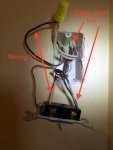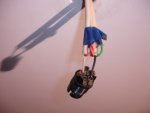- Joined
- Jul 18, 2011
- Messages
- 17,711
This might be a question for any licensed electricians in the crowd . . .
I am putting in some programmable/automatic timer switches for the summer house, replacing the standard SPST switches that were original. In doing so, I ran into some wiring connections that just don;t look quite right. I am wondering if it is just an oversight or perhaps bad wiring. Comments welcome.
Here are a couple of pics.
It is a light switch for the outside light over the garage doors. I am replacing it with a programmable switch that will turn the light on/off automatically. I've already hooked up 2 other programmable switches with good results. This will be a third light outside light on automatic control.
So, I can see 2 hot leads coming into the switch, so it appears the hot is daisy chained to another location along the circuit. What strikes me as odd is the white whire going to the light fixture connected to the 'hot' side and the black wire mated with the white 'ground/neutral' wires.
the light works fine, but it just seems like the color scheme has not been adhered to . . . basically, it would seem like the white/black leading to the switch should be reversed for conformity purposes.
Comments/thoughts?? Would there be another legitimate reason that they are reversed?
I am putting in some programmable/automatic timer switches for the summer house, replacing the standard SPST switches that were original. In doing so, I ran into some wiring connections that just don;t look quite right. I am wondering if it is just an oversight or perhaps bad wiring. Comments welcome.
Here are a couple of pics.
It is a light switch for the outside light over the garage doors. I am replacing it with a programmable switch that will turn the light on/off automatically. I've already hooked up 2 other programmable switches with good results. This will be a third light outside light on automatic control.
So, I can see 2 hot leads coming into the switch, so it appears the hot is daisy chained to another location along the circuit. What strikes me as odd is the white whire going to the light fixture connected to the 'hot' side and the black wire mated with the white 'ground/neutral' wires.

the light works fine, but it just seems like the color scheme has not been adhered to . . . basically, it would seem like the white/black leading to the switch should be reversed for conformity purposes.

Comments/thoughts?? Would there be another legitimate reason that they are reversed?
Last edited:




















